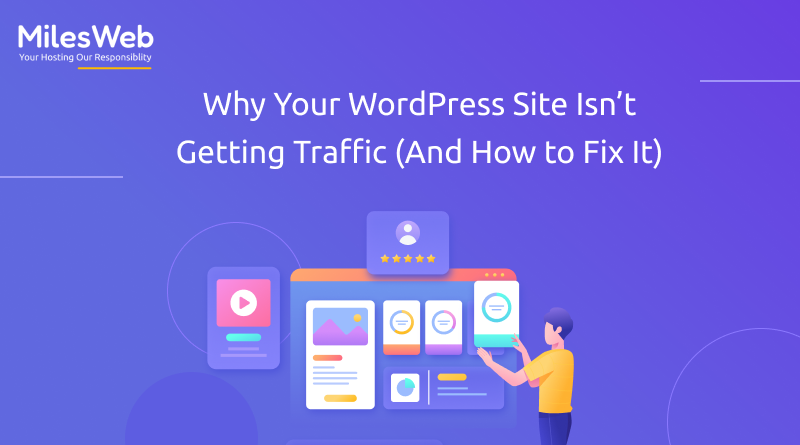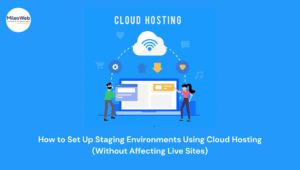You’ve put in dedicated efforts and invested resources to launch your WordPress website. It’s built with a sleek design, features key functionalities, and even ensures WordPress hosting costs are within your budget limit. Despite all these factors, your website still lacks the visitor count that it deserves.
It’s incredibly disappointing for you. After so much effort, your website analytics show stats that are painfully low. What’s the missing element?
Most WordPress beginners, especially small business owners, believe that once their website is live, it’ll start attracting traffic. Affordable web hosting for small business owners is a great choice, but neglecting a well-thought plan can become a hurdle in achieving the objectives.
Ineffective SEO Tactics
You can’t take SEO (Search Engine Optimization) lightly as an optional element. It’s an essential strategy to ensure better website performance in search engine ranking. Newbies often make the mistake of overlooking SEO or relying too heavily on plugins like Rank Math or Yoast to perform all the SEO tasks. But, you can only benefit from the features of these tools if you know their effective use.
What’s causing the problem:
- Poor keyword research approach
- Unoptimized titles and descriptions
- Poorly connected site pages
- Images without Alt text
- Inconsistent URL formats
How to address it:
Kick off your SEO strategy with an emphasis on keyword research using no-cost platforms like Google Keyword Planner or Ubersuggest. Start targeting a post with a particular keyword to boost SEO effectiveness. Write clear and engaging meta descriptions to improve search engine appeal and drive user interest. Ensure your web page URLs are SEO-optimized and search engine bots can easily crawl.
Sluggish Website Speed
Fast-loading web pages is mandatory according to SEO standards, keeping users intact. When users visit a particular website, they demand a quick-functioning site that serves their purpose without a hassle. The slower speed is often a result of subpar hosting services and bloated websites.
What’s causing the problem:
- Unreliable hosting causes slow page loads
- Unnecessary integration of plugins
- Bloated themes cost performance
How to address it:
Website speed is the ultimate factor that decides the success rate of a website. Using a lightweight theme for a website is the best possible way to achieve quick page loads. If your website faces frequent issues, consider switching a hosting plan or changing your service provider.
Missing Content Direction
When attracting new users to a website or ensuring repeat visitors, well-optimized content is a significant factor. Randomly posting content and suddenly breaking the posting loop is a bad content strategy. It’s worth noting that search engines favor website rankings that regularly deliver content and accurately meet user needs. With no clear plan and consistent efforts, your website could face serious trouble.
What’s causing the problem:
- Unsteady content posting that disrupts momentum
- Random content without a defined niche
- Using plagiarised content regularly
How to address it:
You should start your content roadmap using a calendar to schedule posts and meet specific goals within the time limit. Create content that solves readers’ problems and what they continuously seek on search engines. Your every content post should deliver value in the form of actionable advice. Avoid using duplicate content that lacks clarity and drives users away.
Subpar Mobile Responsiveness
In today’s mobile-driven world, most users prefer mobile devices for browsing stuff on the go. If a WordPress website isn’t mobile-friendly, it can frustrate visitors and drive them towards other platforms. Additionally, your website hits with a drop in SEO rankings and loses visitor engagement.
What’s causing the problem:
- Outdated themes that aren’t mobile-adaptive
- Ineffective spacing and unreadable text
- Delayed mobile page performance
How to address it:
Always use a highly responsive theme to ensure your website is operational on all screen sizes. Use readable fonts and proper spacing that make it easy to read on smaller screens. Continuous check for content presentation through the Mobile-Friendly Test of Google. It can help you detect issues like cut-off text and slow-loading media.
Missing Out on Email List
Lesser email marketing activities can be a costly mistake for WordPress site owners. SEO and social media platforms are crucial mediums to drive traffic, but only email marketing can help you build a long-term relationship.
What’s causing the problem:
- No visible opt-in forms or downloadable freebies
- Following manual way instead of email automation
- No proper segmentation of email subscribers
How to address it:
You can attract new subscribers using lucrative offers in the form of a printable checklist, downloadable guides, or special coupons. Use popular email marketing platforms like Mailchimp to deliver personalized content and build strong connections with your subscribers.
Misjudging Hosting Capabilities
At the core of all your strategies, a back-end component called a hosting solution plays a crucial role. Don’t overthink the WordPress hosting cost because cheap hosting can lead to landing on servers that fail under real traffic pressures.
What’s causing the problem:
- Traffic spikes cause shared hosting to fail
- Bandwidth caps or CPU throttling negatively impacts
- Absence of CDN integration and automatic caching
How to address it:
If your website is in the early, you can opt for affordable web hosting for small businesses that seamlessly adjust resources according to requirements. Don’t bother paying the extra cost for some game-changing performance boosters that act as the key traffic attraction factor.
Conclusion
As a WordPress website owner, getting consistent and quality traffic means more than starting an appealing site. You need to continuously refine your content strategies, improve loading speeds, and offer visitor-centric features.
You can turn a WordPress website into a traffic magnet by setting a solid foundation. Start with essentials, avoid repeating mistakes, and improve the website’s performance. WordPress has all the resources that enable it to enhance website functionality; you need to use them effectively.





